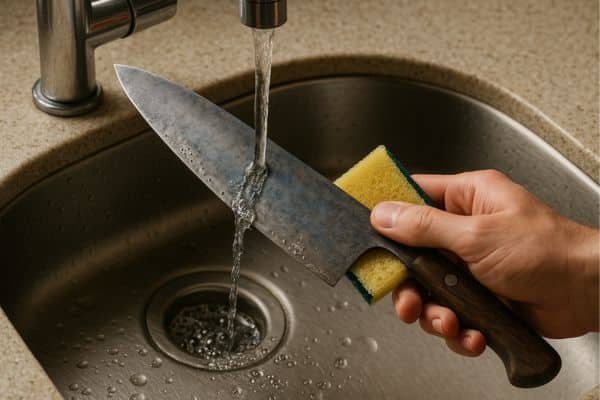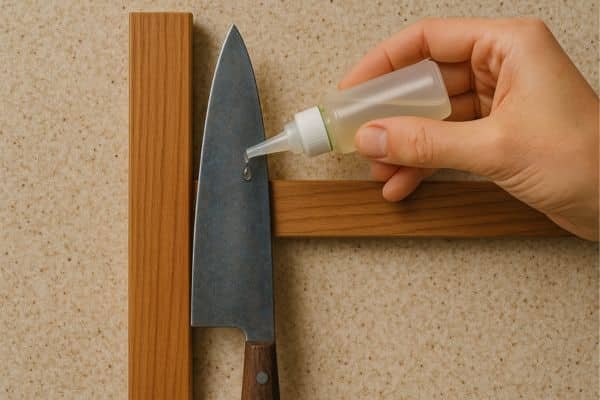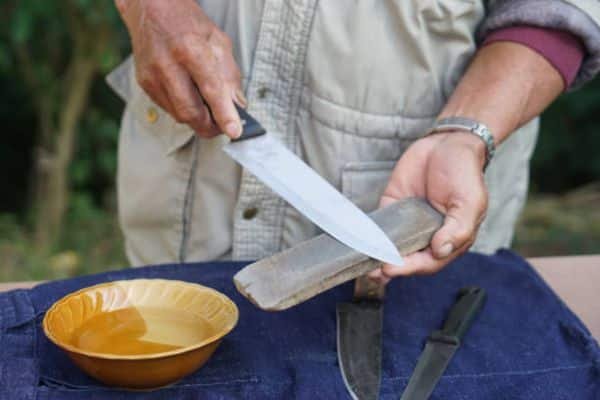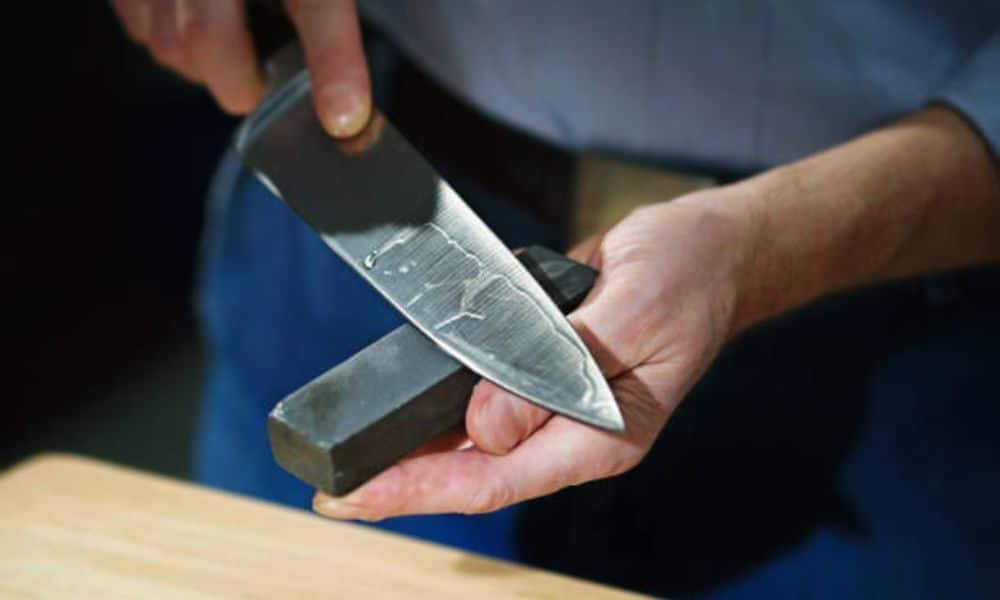The first time I used a carbon steel knife, I was nervous. It looked sharp, felt heavy, and had no shine. I sliced into a ripe tomato and paused. The cut was clean—like silk through water. I smiled. This felt different. It didn’t stay perfect for long. I left it on the counter, damp from the tomato. Hours later, rust had bloomed. I panicked and scrubbed. That made it worse. Lesson learned. A carbon steel knife isn’t like other knives. It wants care. But it gives back so much. Grip, balance, and the joy of real control. It becomes yours, shaped by use and time. Learning how to care for a carbon steel knife changed the way I cook. Now, it’s habit. Simple steps, done with care. The blade stays sharp. The bond grows strong. This guide will help you build that habit.
What Is a Carbon Steel Knife?
A carbon steel knife is simple but powerful. It’s made from iron and carbon—no chrome, no fancy extras. That mix gives it a razor-sharp edge that cuts clean and fast. It feels like an extension of your hand.
Now let’s talk stainless. Stainless steel has added elements like chromium to resist rust. That’s great for ease, but you trade off some sharpness and control. Stainless stays clean longer, but carbon steel stays sharper longer.
So, why do chefs love carbon steel? Control. Precision. Feel. It responds to the way you move. Whether you’re slicing onions or carving a roast, it glides with you. It grows with you. And over time, it develops a patina—like a fingerprint from years of use.
But here’s the deal: this knife needs love. It doesn’t like to be left wet. It won’t forgive neglect. That’s where carbon steel knife maintenance comes in. A few simple habits will keep it strong for life.
Why Carbon Steel Needs Extra Care

Carbon steel is like cast iron. Strong, sharp, and full of soul—but it has its moods. Leave it wet, and rust creeps in. Cut an onion, and the blade starts to darken. That’s patina forming—its natural shield.
Patina matters. It’s not dirt, not damage. It’s a sign of life, like the golden coat on your favorite skillet. This thin layer protects your knife from deep rust. Over time, it turns the blade from shiny to smoky blue. That’s a good thing.
Then there’s the edge. Carbon steel holds it well. It cuts clean and fast. But it chips if you misuse it. Push down too hard or twist on bone, and the edge may give. Like a good friend, it’s honest. It tells you what it likes.
Here’s the truth: this knife wants care, not pampering. Wipe it. Dry it. Oil it now and then. The same way you’d treat cast iron after making a stew. A little time, a little love—and it lasts forever.
How to Care for a Carbon Steel Knife
01. Wash right after use

Rinse with warm water and a soft sponge. No soap needed most of the time.Never leave it in the sink—not even for a minute.
02. Dry with a towel—completely
Use a clean cloth and dry the blade right away. Water is the enemy here. For extra care, wave it over a burner for 2 seconds to finish drying.
03. Add a thin layer of oil

Use food-safe mineral oil or camellia oil. A drop or two is enough. Keep a small bottle near your sink to make it part of your routine.
04. Store it safely
Use a magnetic strip, blade guard, or wooden block. Keep it dry and upright. Never toss it in a drawer—it can chip or get moisture trapped.
Carbon Steel Knife Maintenance Tips for Everyday Use

Once you build the habit, caring for your knife feels easy. These quick tips make daily use smooth and stress-free—especially if you’re using one from the Best Kitchen Knife Set Under $100 that offers great quality without breaking the bank.
Skip the dishwasher. Always.
Heat, steam, and harsh soap will ruin the blade. Wash it by hand, and do it right after use. Think of it like washing your hands—quick, gentle, and often.
Don’t soak the knife. Ever.
Even a few minutes in water can cause rust. Use it, wash it, dry it. That’s the rhythm.
Choose the right cutting board.
Use wood or soft plastic. Glass boards may look sleek, but they dull your edge fast. A well-oiled wooden board is your knife’s best friend.
Carbon Steel Knife Sharpening: Keep It Razor Sharp
A sharp knife makes cooking feel smooth and fun. With carbon steel, you get an edge that slices clean. But it needs the right care to stay that way.
So, how do you sharpen it?
Start with a whetstone. It’s gentle, precise, and ideal for carbon steel. Use a 1000 grit to shape the edge. Finish with 6000 grit for a fine polish. Go slow. Let the stone do the work.
What about honing rods?
Use one to keep your edge aligned. It doesn’t sharpen but keeps the blade from dulling too fast. Ceramic rods work best for carbon steel.
How often should you sharpen?
Once a month is a safe start. More often, if you cook daily. Less if you just prep a few veggies now and then.
Choosing the Right Knife for You
Not all carbon steel is the same. Some are softer. Some stay sharp longer. Picking the right one depends on how you cook—and how much time you want to spend caring for it.
Blue Steel (Aogami)
This is the most balanced. It holds an edge well and resists rust a bit more than others. It’s great for daily cooking. Best pick for beginners who want great performance without too much stress.
White Steel (Shirogami)
Sharpens fast and gets razor-thin. But it rusts quickly and needs more care.
Common Mistakes to Avoid
Even with the best intentions, it’s easy to make small mistakes. Here’s how to dodge the big ones and keep your knife in top shape.
Leaving it wet
This is the fastest path to rust. Always dry your knife right after washing. Even a few drops of water can leave marks overnight.
Skipping oiling
Without oil, carbon steel is exposed. A light coat helps fight moisture and keeps the blade smooth. A few seconds of care now saves hours later.
Sharpening too hard or at the wrong angle
Pressing down too much or holding the blade wrong can chip the edge. Use light strokes and a steady angle. Stick to 15–20 degrees—most carbon blades like it there.
Storing loose in a drawer
This dulls the edge fast and invites damage. Store it with care. Use a sheath, magnetic strip, or wooden block—never toss it in.
Conclusion
A carbon steel knife isn’t just a tool—it’s your kitchen companion. It tells a story every time you use it. With each slice, each wipe, each drop of oil, it becomes more yours.
Yes, it asks for more care. But that care becomes second nature. Just like rinsing your pan or wiping the counter, it turns into a habit. Simple, honest, and satisfying.
The joy comes not from having a perfect knife, but from learning to live with it. To grow with it. What starts as upkeep turns into pride.

